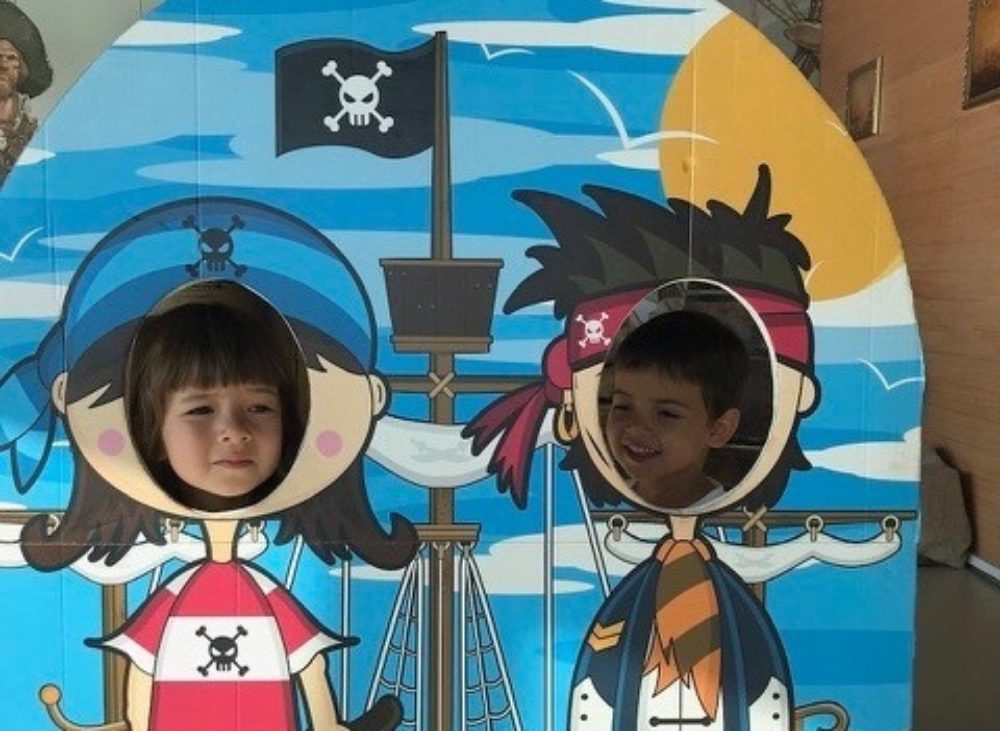
Our daughter, Minh, turns five in December. She’s a cheese connoisseur, and is just learning to swing on the monkey bars. Our son, Henry, is thirteen months younger. He seems to be exiting the stage at which he was a walking reference guide on construction equipment. He appears to be the only member of the family who stands a solid chance of learning how to sing in tune.
We’re tremendously fortunate with these two. There are, as yet, no big dilemmas to wrestle. My difficulties as a father, small and ever-present, are simply the challenges of navigating gracefully each moment at hand: handling the frequent flashpoints that, like most parents, I’m certain I fumble far more often than I land.
After Peter Drucker arrived in Heaven, once the Higher Powers fleshed out Drucker’s collected works to arrive at a truly definitive version ofThe Practice of Management, I’m sure that it must have come to include a long chapter on “Disorders of the Moment at Hand.” These are different from failures of strategy, failures of design, bad choices about people, and most other pathologies we encounter. In disorders of the moment at hand, our best selves lose their way in the fog of action, and we go astray.
For some people, the characteristic weakness in these moments is distraction. Others dive into the prickly weeds of micromanagement. Dominate. Feign agreement. React too fast. Shun risk. Vacillate. There are a litany of variations of how we act when caught up in the present moment of action.
A few years ago, I wrote a post called “What I Need to Learn Next” about areas of focus in my own development, and in particular my own characteristic disorder of the moment at hand as a leader, a kind of curt impatience that manifests especially when I’m under high time pressure and moderately high stress, or when people bring me certain kinds of small issues that I wish I could glide past. I’ve reflected often since on just how hard this issue is to work on. As with other disorders of the moment at hand, the very self that is trying to improve slips away at precisely the times his efforts are most needed.
It’s kind of like parenting. I know that when Henry goes limp in the bath, shouting no and refusing to be washed, even though – or probably because – it is a few minutes before eight and we should really be progressing to story time, there must be a good alternative to steady escalation on both sides. But I encounter a kind of flooding and tunnel vision there, in the fog of action, that obscures the possibilities of cycling through the ways I might make him laugh, distract him, somehow effect a reset for the thirty seconds needed to get the evening back on track.
Enter Daniel Siegel and Tina Bryson’s No-Drama Discipline, which is at once a practical guide to something no parent I know feels they consistently do well, and a roadmap for the much broader field of disorders of the moment at hand.
As with most advances, practical progress begins with simple concepts and clear principles. Siegel and Bryson paint a picture: “Instead of being reactive, we want to be responsive to our kids. We want to be intentional and make conscious decisions based on principles we’ve thought about and agreed on beforehand. Being intentional means considering various options and then choosing the one that engages a thoughtful approach toward our intended outcomes.” In other words: “What’s needed is a clear understanding of what you actually want to accomplish when your child misbehaves.”
Siegel and Bryson then set about proposing that underneath some useful general principles they delineate about how discipline can reinforce connection between parent and child and teach skills, an effective specific response to misbehavior hinges on answering three questions:
- Why did my child act this way?
- What lesson do I want to teach in this moment?
- How can I best teach this lesson?
(One fundamental observation about the third question is that a lesson is rarely best taught now with the child’s feelings and actions spun out of their control.)
Too many people fail to act on good concepts, and then rush to a decision that concepts are useless. They’re half right. Concepts are useless without the connective tissue that pull them all the way through to effective action in the moment at hand.
With disorders of the moment at hand, the connective tissue problem is especially difficult, because the self who has the concept has likely already been lost by the time the critical point in the action arrives.
What can be done?
To build the right connective tissue, we need to start by developing and practicing a repertoire of plays, much more tactical and granular than the concepts they serve.
To give a sense of what such a play looks like, here’s a short passage inside a section Siegel and Bryson label Connection Strategy #1: Communicate Comfort.
One of the most effective and powerful ways to [communicate “I’m not a threat”] is to put your body in a posture that’s the opposite of imposing and threatening. Lots of people talk about getting at a child’s eye level, but one of the quickest ways to communicate safety and the absence of threat is to get below the child’s eye level and put your body into a very relaxed position that communicates calm. You see other mammals doing this to send the message “I am not a threat to you. You don’t need to fight me.”
Plays are useful only if they can be practiced as discrete elements. Think of a ski instructor asking a beginning student to hold his poles out in front of him horizontally in both hands to teach arm posture. The play of “below the child’s eye level” is an equally discrete element, equally suited to drill-like repetition. Usefully, this particular play isn’t hard to practice during a child’s good-humored moments, so that it is readier at hand in the tumult of a tantrum.
No one becomes a good athlete, in any sport, simply by playing as comes naturally. Improvement demands isolation of elements, which become internalized only through practice. Pressure always threatens to break form. The work that matters is always nine parts on the practice field to one part on the playing field.
Of course, as any parent can attest, the really hard part about running these plays is remembering to run them. That’s the crux of the dilemma in disorders of the moment at hand.
The most important plays aren’t so much the outer plays, like getting below the child’s eye level, but the inner plays, of which the truly essential ones revolve around noticing.
Siegel and Bryson write about “turning down the shark music.” Here’s Siegel narrating an approach from his workshops:
First, I ask the audience to monitor the response of their bodies and minds as I show them a thirty-second video. On the screen, the audience sees what appears to be a beautiful forest. From the point of view of the person holding the camera, the audience sees a rustic trail and moves down that path toward a beautiful ocean. All the while, calm, classical-sounding piano music plays, communicating a sense of peace and serenity in an idyllic environment.
I then stop the video and ask the audience to watch it again, explaining that I’m going to show them the exact same video, but this time different music will play in the background. The audience then sees the same images – the forest, the rustic trail, the ocean. But the soundtrack this time is dark and menacing. It’s like the famous theme music from the movie Jaws, and it completely colors the way the scene is perceived. The peaceful scene now looks threatening – who knows what might jump out? – and the path leads somewhere we’re pretty sure we don’t want to go. There’s no telling what we’ll find in the water at the end of the trail; based on the music, it’s likely a shark. But despite our fear the camera continues to approach the water….
With this experience as a prompt, Siegel teaches parents to “pay attention to our background music” – where attention is the critical variable. Turning down the shark music once one notices it’s playing often isn’t all that hard. Noticing and synthesizing “shark music” once the track begins to play is the hard part. We’re accustomed to going immediately into our reaction to the shark music, rather than to noticing that shark music has begun to play.
How can a parent learn to notice “shark music” when he previously would have skipped noticing and begun panicking about the shark?
Siegel and Bryson counsel the art of the pause.* Which is of course not only the right advice, but kind of the whole game. After all, at the very heart of all disorders of the moment at hand is the failure to pause.
Profound as No-Drama Discipline is on the specifics of disciplining children, it doesn’t linger long enough on this question of how to learn to pause, even when all the momentum of the situation pulls the other way. One of the best students of this question is W. Timothy Gallwey. Turn to his The Inner Game of Work, where he writes about his experience as a tennis coach:
When my student complained about his faulty backhand, I would tell him that I wanted to postpone fixing it until later. All I wanted him to do now was to observe some detail of the ball. For example, I might ask the student to notice whether the ball was falling, rising, or level at the moment of contact with the racket. I would hasten to say that I wasn’t asking him to make any change, but just to observe what was happening.... When I could hear the neutrality of observation in his tone of voice, I knew that his mind-set was no longer a judgmental one, at least for the moment. What amazed me at first, but which I later came to expect, was that in this nonjudgmental mode of observation of the ball, many of the technical elements of his swing would change spontaneously!
The element that can be practiced here, Gallwey shows us, is simply the art of noticing. Get used to listening to the inner music, listen for the varieties of the birdsong, and it becomes easier to pause when the shark music begins – to feel, naturally and without strain, that it demands a pause.
Let’s move back to the domain of management, and each person’s characteristic disorders of the moment at hand. What Siegel and Bryson show us is simple and essential:
- Change begins in a positive picture of how one wants to lead, that begins at a conceptual level
- Those concepts must be translated into the connective tissue of specific plays that translate clear, precise intentions into effective action
- These plays must be practiced, frequently enough to become internalized
- The most important element to practice is the discipline of noticing a pause is needed, and in that pause arresting the default reaction and setting into motion the intentional play
Reflecting on this mental map makes clearer to me why it is that I’m more effective emotionally in dealing with big reversals than small annoyances, and handle the sharks better than the gnats. When the big stuff happens, I’ve learned to pause. Too often when the gnats are biting, I just push onwards and react.
Seeing this pattern and this need doesn’t itself effect a change. When a coach shows an athlete where his form breaks down, that doesn’t itself resolve the problem. It highlights where to practice, and highlights what to notice – which points the way to a better result.
As I’ve written elsewhere, “work” and “life” often aren’t separate spheres of development. We develop in counterpoint, with each domain of life providing clues and practice fields for the others. Siegel and Bryson show us a way of thinking and practicing as parents that illuminates how to deal with the disorders of the moment at hand that hold us back at work, and thus their book on parenting skillfully points the way to becoming a more effective leader. Even more valuable, in my own mind, is the prospect that I might use my time at the office to practice the qualities of attention and the arts of self-control that will make me a more effective parent. Neither children nor companies stand still. Siegel and Bryson teach how, by cultivating a greater stillness in ourselves, we can respond with grace and reason to those trials that most often rout our better angels.
* This word “pause” would be worth its own volume. That volume might begin with reflection on Venkatesh Rao’s wonderful and under-read book Tempo, and continue with a meditation on my friend Dov Seidman’s work, such as this essay in Strategy & Business on “Starting with a Pause.”



